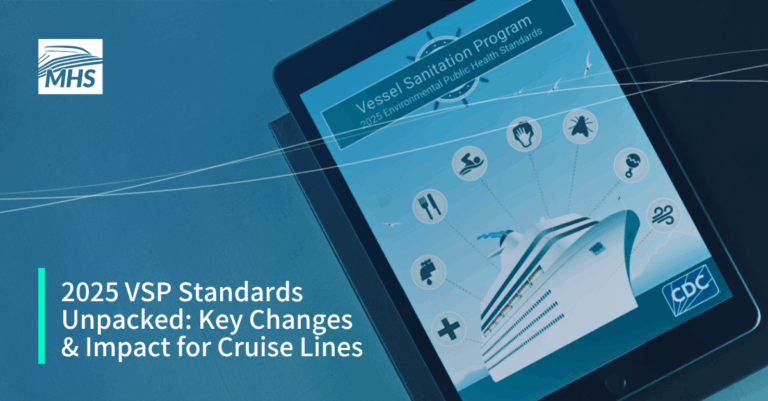The CDC’s newly released Vessel Sanitation Program (VSP) guidelines signal a major turning point in cruise ship public health. For the first time in the program’s history, the standards move beyond Acute Gastroenteritis (AGE) prevention to include proactive surveillance for Legionella.
Rebranded as the 2025 VSP Environmental Public Health Standards, the manual reflects the latest scientific research and brings requirements into closer alignment with other U.S. regulatory frameworks such as the FDA Food Code and the Model Aquatic Health Code.
From enhanced water safety protocols to new time-control measures, the revised standards introduce changes that will significantly impact day-to-day cruise operations.
In this article, we unpack the key updates—and what they mean for cruise lines working to stay compliant while protecting passenger and crew health.
Note: For ease of reference, each heading corresponds to the relevant chapter, subsection, and section number in the 2025 VSP manual.
Table of Contents
Chapter 4: Acute Gastroenteritis (AGE) Surveillance
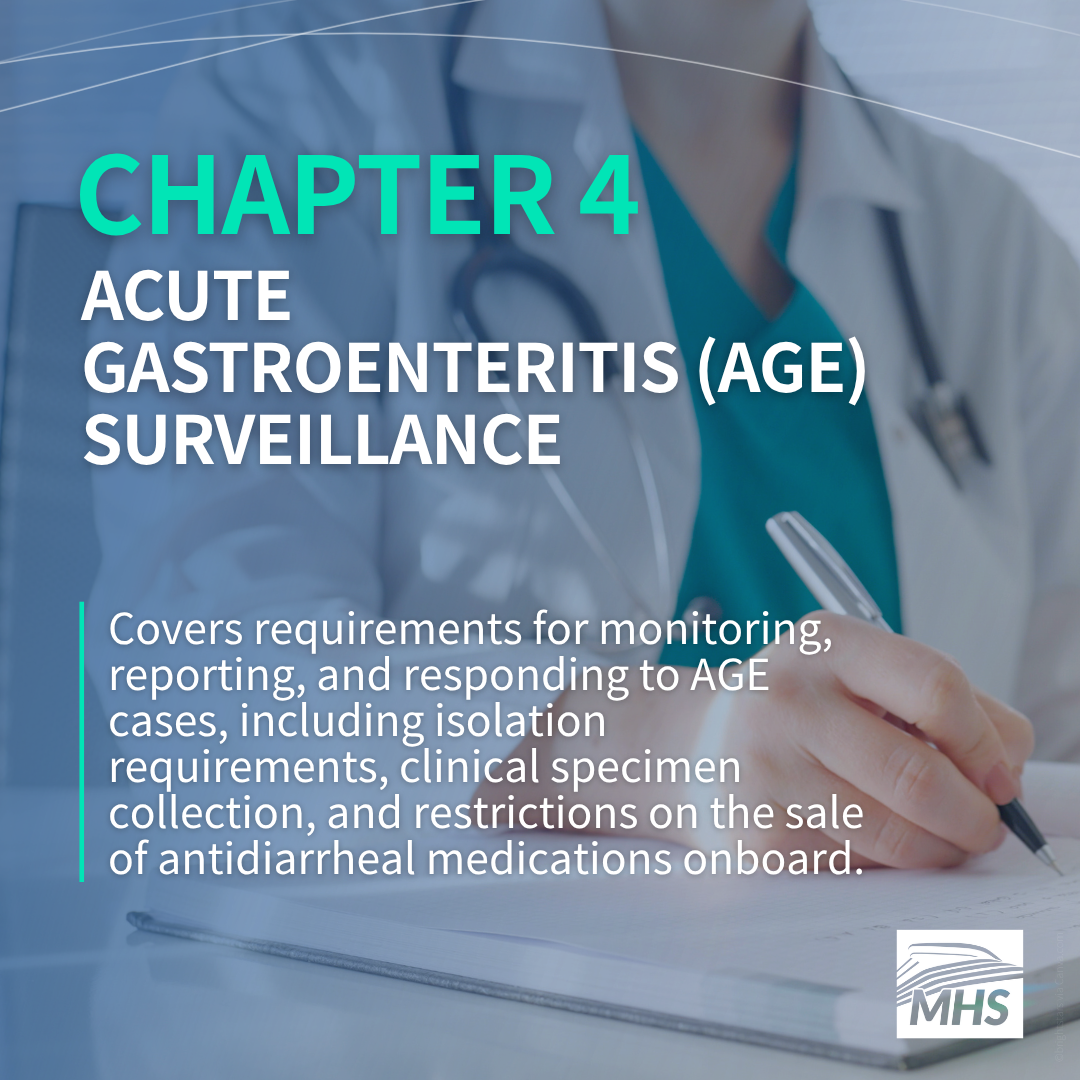
Section 4.1.2.3 – AGE Surveillance Log Details
What’s new:
The 2025 standards now clearly state:
“All fields of the AGE surveillance log must be completed, even if entry is zero or nonapplicable. If a field is not completed, document the reason in the notes column (for example, a virtual consultation).”
What it means:
While this expectation existed under the 2018 standards—and ships were cited for incomplete logs—the updated language removes any ambiguity. Every field must be completed, or the reason for leaving it blank must be clearly documented. The new guidance simply reinforces what was already established.
Section 4.1.4 – Retention and Review
What’s new:
Ships are required to retain “documentation of follow-up actions for public vomit or diarrhea incidents.”
This includes confirming whether the person involved meets the definition of a reportable AGE case and determining whether isolation is necessary.
What it means:
The 2018 manual implied that these incidents should be investigated, but it wasn’t explicitly required. The 2025 update closes that gap.
Ships must now ensure all follow-up actions are both taken and documented, including notifying onboard medical staff so the individual can be clinically assessed.
Chapter 5: Potable Water
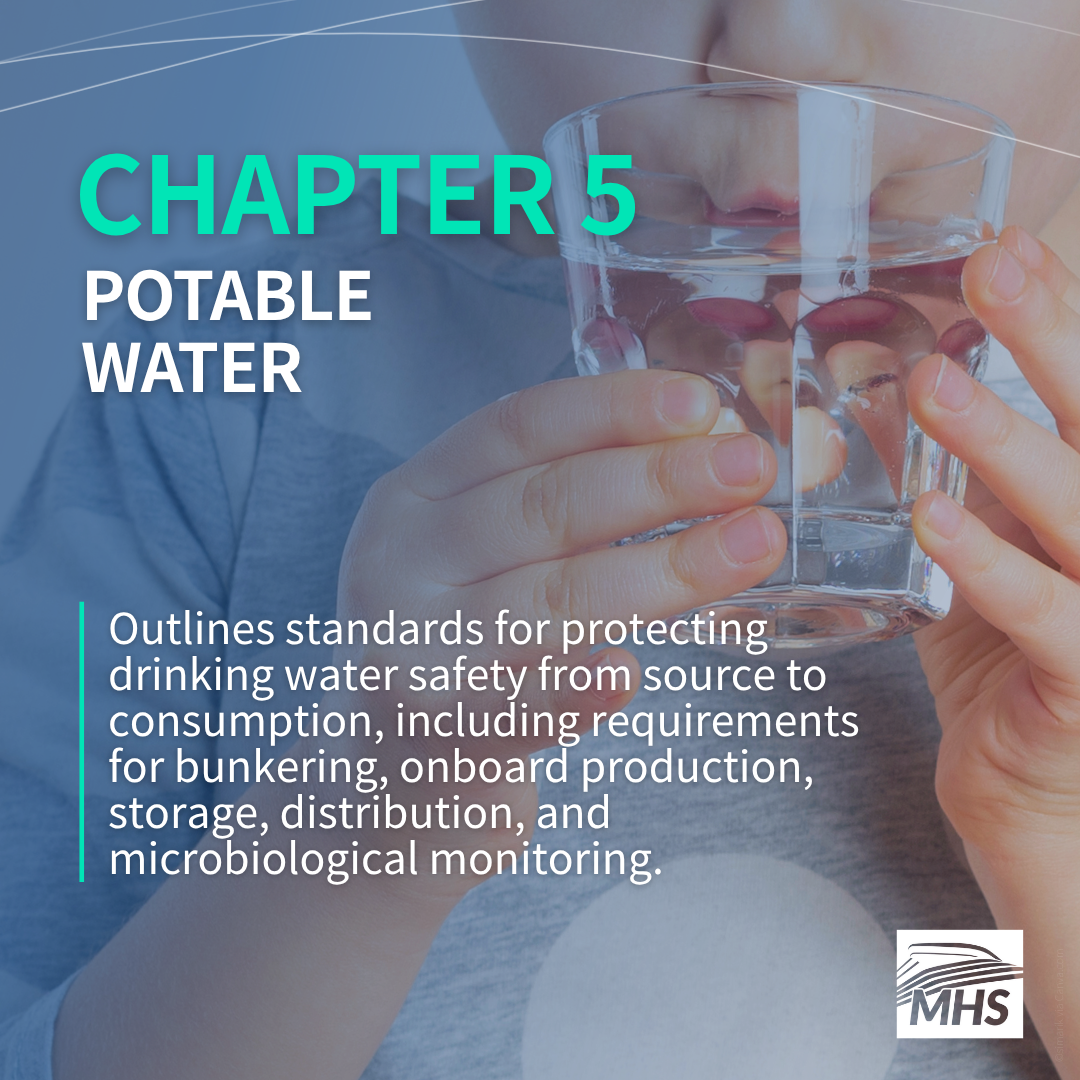
Section 5.2.1.2.4 – Calibration of Analyzer-Chart Recorders or Data Loggers
What’s new:
Electronic data loggers have been added to the list of equipment that must be calibrated before producing or bunkering potable water. The updated standard states:
“Halogen and pH analyzer-chart recorders or data loggers used instead of manual tests and logs must be calibrated at the beginning of bunkering or production and each time bunkering or production is restarted. Calibration must be recorded on a chart or in a logbook. Calibration done, checked, verified, or similar language is acceptable.”
What it means:
While most cruise ships use analyzer-chart recorders, newer vessels may rely on electronic data loggers to monitor halogen and pH levels. Some of these systems include built-in calibration or continuous self-checks, but the requirement for documented calibration now applies to them as well.
Whether this can be done easily before each bunkering or production cycle will depend on the system’s capabilities. Regardless, the expectation is now clear: calibration must be performed, recorded, and be verifiable.
Section 5.3.1 – Fixtures That Require Potable Water
What’s new:
A requirement previously found in the VSP 2018 Construction Guidelines has now been added to the operational standards:
Only potable water must be supplied to the following areas and plumbing connections, regardless of the locations of these fixtures on the vessel:
- All showers and sinks (not just in cabins)
- Chemical feed tanks for the potable water system or RWF systems
- Drinking fountains
- Emergency showers
- Eye wash stations
- Food areas
- Handwashing sinks
- HVAC fan rooms (Applies to vessels built or renovated in accordance with the 2011 VSP Construction Guidelines or later)
- Medical facilities
- Deck and window cleaning facilities (Applies to vessels built or renovated in accordance with the 2018 VSP Construction Guidelines or later)
Note: Utility sinks in engine/mechanical spaces are excluded from the above requirements.
What it means:
This revision formally establishes an operational requirement to supply only potable water to all listed fixtures. Most modern ships are likely already compliant, but older vessels—especially those built before the 2011 Construction Guidelines—may require costly plumbing upgrades to meet the standard.
Section 5.3.5.1 – Disinfecting
What’s new:
While previously implied, it’s now clearly stated that:
“Backflow prevention devices that are part of the potable water piping must be disinfected before installation.”
What it means:
This update clears up a common inspection issue by explicitly including backflow prevention devices in the requirement that all affected parts of the potable water distribution system must be cleaned, disinfected, and flushed with potable water before installation.
Interestingly, the same section also states that all affected parts must be cleaned and disinfected after contamination. Does this mean that, in the event of system-wide Legionella colonization, ships would be expected to remove and clean every backflow preventer on board?
Probably not, but the wording leaves room for interpretation. This may be an area where further industry clarification is needed.
Section 5.3.5.4 – Flush
What’s new:
After cleaning and disinfecting components of the potable water system, ships must flush the system with potable water until the free halogen residual is ≤ 5.0 mg/L (ppm). The 2025 update adds a new requirement:
“The free halogen test result must be documented with a specific value measured.”
What it means:
This change confirms that vague log entries like “OK” or “complete” are no longer acceptable. A specific chlorine value in ppm must be recorded to verify the flushing step was done properly.
The accompanying section (5.3.5.5 – Record Retention) has also been updated to require that the measured free halogen residual after flushing be documented and retained onboard for 12 months.
Section 5.5.2.2.3 – Chart Review
What’s new:
Electronic data loggers have now been explicitly included in the requirement that chlorine residual monitoring records from the vessel’s distribution system must cover “at least 16 hours in each 24-hour period.”
Previously, this language applied only to halogen analyzer–chart recorders.
What it means:
This is more of a clarification than a new requirement. The 2018 manual already implied that electronic data loggers should meet the same principles and data expectations as analog chart recorders. The 2025 update simply formalizes that interpretation.
Section 5.6.1.1.2 – Legionella—Potable and Nonpotable Water
What’s new:
For the first time in the history of the Vessel Sanitation Program, the 2025 standards introduce specific requirements for Legionella sampling.
Cruise ships must now sample their potable water systems at least every six months, with the number of samples based on the vessel’s size and system complexity. The sampling plan must include a selection of the following locations:
- Potable water storage tanks
- Water heaters and hot water storage
- Hot water return lines
- Representative points of use in cabins, galleys, and recreational areas
- Include a mix of fixture types (showers, sink faucets, tubs)
- Include potable water samples when temperatures are in the range favorable for Legionella growth (25°–45°C, 77°–113°F)
- Decorative water features
- Misting systems
- Salon and pedicure devices
- Technical water sources with a risk of exposure via aerosolization to crew or passengers, such as deck washing
If Legionella is detected, ships must take follow-up action based on the species, concentration (e.g., CFU/mL), and extent of colonization. These actions include:
- Reviewing the vessel’s water management program
- Conducting a root cause analysis
- Updating the water management program, if necessary
- Retesting affected fixtures or systems to confirm that remediation efforts were effective
What it means:
Routine Legionella sampling is now mandatory, and cruise lines will need to plan ahead to meet the six-month requirement. Onboard testing is allowed and may help with this, though it’s important to understand the limitations of certain rapid test kits—a point we’ll return to later in this article.
Section 5.6.1.1.3 – Legionella—Recreational Water Facilities and Heated Jetted Tubs
What’s new:
All spa pools, whirlpool spas, and heated jetted tubs must be sampled for Legionella at least every 3 months. If Legionella is found, follow-up sampling must be conducted. Samples must be collected at least 48 hours after the facility has been restored to normal operating conditions after remediation.
Note: Ships may test for Legionella every 6 months if the following criteria are met for the 24 previous months:
- Negative Legionella test results for the spa pools, whirlpool spas, and heated jetted tubs
- No legionellosis cases associated with travel on the ship (including after-cruise travel-associated cases identified by public health authorities)
If Legionella is detected, the following steps must be taken:
- Close the RWF
- Add disinfectant and maintain at least 10 ppm of free chlorine for 1 hour
- Drain the water
- Scrub, clean, and rinse all RWF surfaces with fresh potable water and drain as needed
- Clean and service filters according to manufacturer recommendations
- Refill
- Return the RWF to at least the minimum free halogen residual
- Reopen
- Collect follow-up samples
What it means:
This update marks a significant operational change, as quarterly Legionella testing for all spa pools, whirlpool spas, and heated jetted tubs will become standard unless the 24-month exemption criteria are met. This will notably increase workload, especially on ships with multiple private or in-cabin tubs. For most vessels, quarterly sampling will likely be required for at least the first two years unless they have sufficient historical testing records to qualify for the exemption.
Section 5.6.1.1.4 – Analysis
What’s new:
The 2025 VSP guidelines clarify that onboard Legionella testing is acceptable if the test kits are validated to a recognized national or international standard. Additionally, the test kits and associated equipment must be operated and maintained according to the manufacturer’s specifications.
What it means:
Onboard Legionella testing can be a useful tool for cruise lines; however, it is important to recognize its limitations. While rapid tests offer quick results, their scope and sensitivity may be limited. Some only detect Legionella pneumophila serogroup 1—missing other serogroups or species—and can have detection limits above 100 CFU/L.
Certified external laboratories, while taking up to three weeks for culture-based results, offer more comprehensive and accurate analysis, reducing the risk of false negatives and increasing confidence in compliance with regulations.
Regardless of the testing method chosen, sample results must be retained onboard for at least 12 months, as per Section 5.6.1.2.1 – Records.
Chapter 6: Recreational Water Facilities (RWFs)
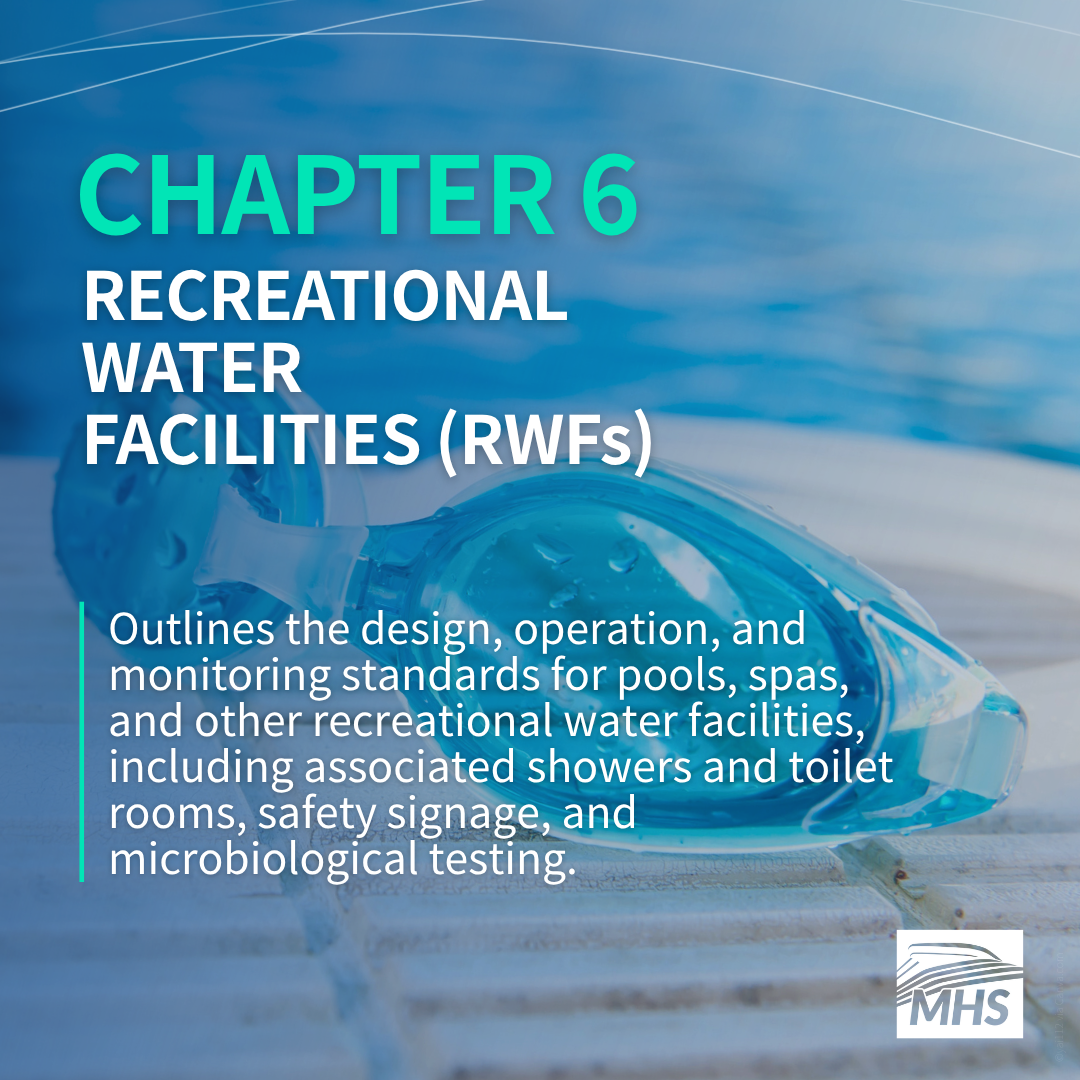
Section 6.3.1.1 – Fill Level and Turnover Rates
What’s new:
The 2025 VSP standards have relaxed the previous requirement that “the fill level of the RWF must be to the skim gutter level.”
The updated standard now states that “the water level must at least reach the skim gutter or overflow level for a portion of the pool perimeter.”
What it means:
This change reduces the burden on ships to maintain an exact fill level along the entire pool perimeter—a common issue flagged during inspections.
Uniform gutter-level fill can be difficult to maintain consistently due to routine fluctuations in pool use and environmental conditions. By requiring the water level to reach the overflow area on just a portion of the perimeter, the revised standard offers greater operational flexibility while still supporting effective surface skimming.
Section 6.3.1.6.1 – Water Chemistry
What’s new:
The clarity of water in an RWF will now be assessed based on the inspector’s ability to clearly see the drain covers at the bottom of the pool when the water is still.
What it means:
This update removes ambiguity by specifying that inspectors will assess clarity when the water is still, creating a more consistent and objective inspection standard.
Section 6.3.1.6.3 – Record of Fecal and Vomit Accidents
What’s new:
Remedial action records must now include the water temperature during disinfection following any fecal or vomit incident in an RWF.
What it means:
This update doesn’t introduce a new operational step, but rather formalizes guidance previously found in the 2018 Manual Annex (Sample Fecal/Vomit Accident Plan), which advised maintaining a water temperature of at least 25°C (77°F) during disinfection.
Operators will now need to ensure this detail is consistently documented in their records.
Section 6.3.2.1.4 – Secondary Ultraviolet (UV) Disinfection
What’s new:
UV disinfection systems capable of inactivating Cryptosporidium parvum must now be installed not only in baby-only water facilities, but also in all children’s pools, interactive RWFs, and activity pools with interactive features such as jets or sprinklers.
Note: This requirement applies only to vessels built or renovated in accordance with the 2011 VSP Construction Guidelines or later.
What it means:
The expanded UV requirement reflects growing concern over Cryptosporidium—commonly known as “Crypto”—a chlorine-resistant parasite responsible for numerous recreational waterborne illness outbreaks.
Crypto spreads when contaminated fecal matter enters the water and is accidentally ingested by swimmers. By targeting facilities designed for or frequently used by children, the new standard aims to better protect this higher-risk group, who are both more likely to swallow water and to introduce fecal matter into it.
For larger fleets, especially those with newer ships featuring multiple RWFs, this change could carry significant financial implications.
Section 6.6.1 – Draining, Cleaning, and Disinfection (Jetted Tub Operations)
What’s new:
Jetted tubs—bathtubs with built-in water jets found in certain passenger cabins—must now be drained daily. They must also be cleaned and disinfected every 7 days or between occupancies, whichever comes first. This builds on the 2018 standards for private whirlpool spas.
For heated jetted tubs—those with a heating element maintaining water temperatures between 25°C and 40°C (77°F–104°F)—cruise lines must choose one of two options:
- Option 1: Drain, clean, and disinfect daily. A safety sign is required at the tub entrance warning users that heated tubs without automated halogen and pH controls may increase the risk of respiratory infections.
- Option 2 (requires an approved variance): Drain every 3 days; clean and disinfect twice weekly or between occupancies, whichever is more frequent. No signage is required.
- To qualify, automated halogen and pH injection systems capable of recording the halogen residual and pH levels at least every 4 hours must be installed.
What it means:
These changes were introduced in response to Legionnaires’ disease outbreaks linked to jetted tubs. Cruise lines must now decide between:
- Taking on a significant increase in crew workload to meet the new draining and cleaning requirements, or
- Investing in automated water treatment systems to qualify for reduced maintenance under a variance
For ships with a high number of private jetted tubs, the operational and financial impact will be substantial.
Section 6.6.2 – Records (Jetted Tub Operations)
What’s new:
Manufacturer’s operation and maintenance instructions must be readily accessible to crew servicing all types of jetted tubs. Maintenance records must be retained onboard for 12 months and include:
- Cleaning and disinfection frequency
- Disinfectant type, concentration, and contact time
- Draining frequency (for heated jetted tubs only)
What it means:
This update reinforces the importance of proper jetted tub maintenance in reducing waterborne pathogen risks. It remains to be seen whether VSP inspectors will verify compliance through physical inspections of tub components or rely primarily on documentation.
Section 6.8.1.1 – RWF Safety Signs
What’s new:
To address frequent inspection findings, the standards now require that safety signs be placed in “a prominent and unobstructed location for all users of the RWF.”
What it means:
Ships must ensure all required safety signs are posted where they are clearly visible and easily seen by all users of the facility.
Section 6.8.2.2 – Antientrapment Covers
What’s new:
The previous standard to have required information stamped directly on drain covers has been relaxed. Ships may now provide manufacturer documentation confirming compliance with safety standards as an acceptable alternative.
What it means:
This update offers greater flexibility in demonstrating compliance with antientrapment cover requirements, potentially simplifying inspections by reducing the need to verify physical markings.
Section 6.9.3 – Toilet Facilities
What’s new:
For facilities built or renovated to the 2018 Construction Guidelines or later, toilets must now be located within 60 meters (197 feet) walking distance of each RWF.
The toilets can be located either on the same deck as the RWF or on adjacent decks, provided there is no obstruction between the RWF area and the toilet entrances.
What it means:
The previous requirement measured distance based on fire zones (an approximate spatial reference of 48 meters). The new standard shifts to a more practical and verifiable metric: walking distance.
Inspectors now have a clearer way to assess compliance which could make enforcement more consistent across ships.
Chapter 7: Food Safety
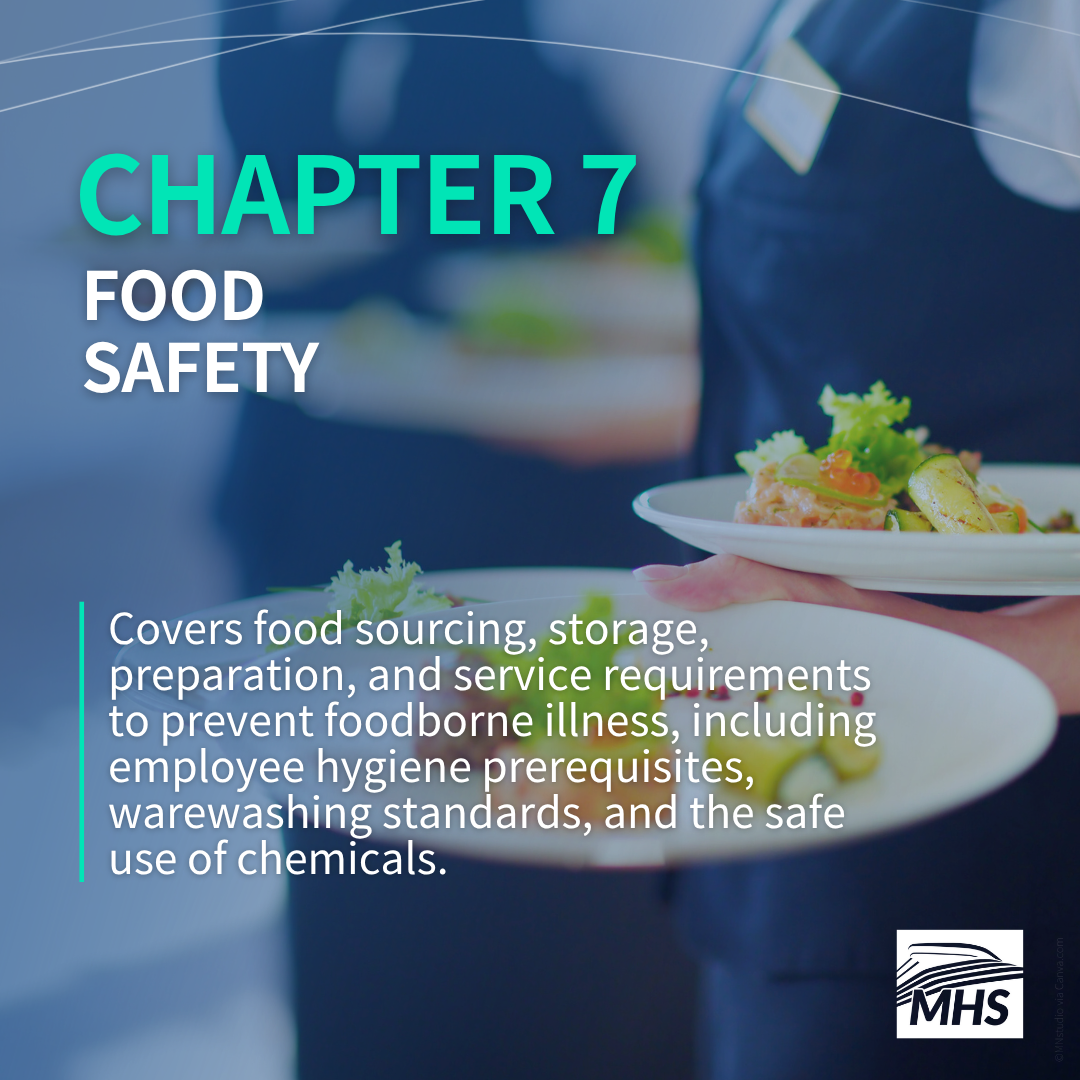
Section 7.2.2.3.2 – Shellstock Identification
What’s new:
The VSP now permits invoices, in addition to tags or labels, as acceptable documentation to record the date when the last shellstock from a specific container was served onboard.
What it means:
This change offers greater flexibility for documenting shellstock traceability. Instead of relying solely on physical tags or labels—which can easily get lost—vessels can now use invoices to record the date when the last shellstock from a batch was served.
Section 7.2.3.2.1 – Cross-Contamination
What’s new:
The 2025 standards clarify that ready-to-eat (RTE) foods containing raw or undercooked animal products must be physically separated from other RTE items to prevent cross-contamination through contact or dripping.
What it means:
This isn’t a new practice but provides clearer guidance on expectations for preventing cross-contamination and ensuring safe food handling.
Section 7.2.4.2.1 – Parasite Destruction
What’s new:
The 2025 standards expand the list of validated freezing methods for parasite destruction in fish that will be served raw or undercooked. Acceptable methods now include:
- Freezing and storing at -20°C (-4°F) or below for at least 168 hours (7 days)
- Freezing at -35°C (-31°F) or below until solid, then storing at -35°C (-31°F) or below for at least 15 hours
- Freezing at -35°C (-31°F) or below until solid, then storing at -20°C (-4°F) or below for at least 24 hours
Exemptions (e.g., for certain tuna species and aquacultured fish) remain largely the same but are now presented with clearer definitions and formatting.
What it means:
This update gives ships and suppliers more flexibility in how they meet VSP’s parasite destruction requirements, while improving clarity around existing exemptions.
Section 7.2.4.3.4 – Commercial Products
What’s new:
A new requirement specifies that commercially packaged foods must be cooked so all parts of the product reach the temperature stated in the manufacturer’s instructions.
What it means:
This update reinforces the importance of following cooking instructions printed on packaging to ensure food safety. If the packaging indicates the product has not been processed to control pathogens, it must be cooked according to the VSP manual’s time and temperature requirements.
Galley teams may need retraining to ensure they fully understand and apply this standard.
Section 7.2.5.3.1 – Holding Temperature/Time
What’s new:
Shell eggs that haven’t been treated to destroy Salmonella can now be held at 7°C (45°F) or below, rather than the standard 5°C (41°F) or below used for other TCS/PHF foods.
What it means:
This update brings VSP policy in line with the FDA Food Code, acknowledging research that shows the higher temperature has minimal impact on Salmonella risk. It gives ships more flexibility in storing shell eggs without compromising food safety.
Section 7.2.5.3.5 – Time as a Public Health Control
What’s new:
Two updates expand time control options (for cold TCS/PHF foods before cooking or RTE TCS/PHF items held/displayed for immediate service):
1. New 6-hour option:
- Food must have an initial temperature of ≤5°C (41°F) and not exceed 21°C (70°F)
- Must be clearly marked with a) the time when the food was removed from temperature control and b) the discard time (6 hours later)
- The food temperature must be monitored throughout
- Must be discarded after 6 hours or if it exceeds 21°C (70°F)
- Cannot be returned to temperature control once removed
2. Expanded 4-hour option (for RTE fruits, vegetables, or sealed packaged items that become TCS/PHF once opened or cut):
- Can have an initial temperature of ≤21°C (70°F) as long as it doesn’t exceed this during the 4-hour window
- Must be clearly marked with a 4-hour discard time
- Time must be counted from when the food became TCS/PHF, even if service setup and closing is less than 4 hours
What it means:
These updates offer more flexibility for cold holding during buffet service or prep, but only if staff are trained and monitoring is consistent.
Cruise lines should:
- Update procedures and retrain food handlers to reflect the added complexity
- Revise labeling practices to clearly indicate correct discard times
- Amend Time Control Plans (TCPs) accordingly
Expect VSP inspections to scrutinize discard labeling, temperature monitoring, and whether TCP documentation matches the time control option in use.
Section 7.6.1.1.3 – Tempered Water
What’s new:
The required minimum water temperature for handwashing sinks in food areas has been lowered from 38°C (100°F) to 29.4°C (85°F).
Note: For sinks without user-adjustable temperature controls, the post-mixing valve threshold remains unchanged at 49°C (120°F).
What it means:
This update reflects evidence that handwashing effectiveness is not compromised at lower temperatures, potentially supporting energy saving initiatives. However, cruise lines should weigh those savings against the needs of their broader Legionella prevention strategy.
Section 7.6.5.2 – Coving
What’s new:
Coving requirements have been expanded to include more junctures and locations:
- Counter/bulkhead/backsplash junctions (now explicitly required)
- Additional areas:
- Scrapping stations
- Food transportation corridors (see the VSP definition for guidance)
What it means:
Expect increased scrutiny during inspections on coving in food transport paths and support areas that may have previously fallen outside the scope.
Teams should reassess all counter and wall junctions in food prep, storage, and transport zones to confirm that compliant coving is installed.
Section 7.6.6.1.2 – 110 Lux/10 Foot-Candles
What’s new:
Light intensity requirements (when lights are in use) have been clarified to apply to specific locations that were previously grouped under the broad category of “other areas and rooms during cleaning operations.”
In addition to walk-in refrigerators and dry storage, the following areas are now explicitly included:
- Linen storage areas
- Waiter stations
- Scrapping stations
- Bar handwashing stations
What it means:
These spaces may now be subject to direct light level measurements during inspection. Operators should assess lighting in each area to confirm it meets the 110 lux minimum and make upgrades where needed.
Section 7.7.6.1.3 – Bars and Waiter Stations
What’s new:
The minimum light intensity requirement of 220 lux during cleaning operations in bars and dining room waiter stations has been expanded to explicitly include open shelves used for storing food or beverages.
What it means:
Teams should confirm that lighting levels for open shelving (used for storing food or beverages) reach the 220 lux threshold and adjust fixture placement or bulb intensity as needed.
Section 7.7 – Water Filling Stations and Drinking Fountains in Nonfood Areas
What’s new:
The 2025 standards introduce specific lighting requirements for water filling stations and drinking fountains located outside food areas.
These units must now have at least 220 lux at both the dispensing nozzle and filling surface during cleaning operations (with the exception of outdoor drinking fountains.)
What it means:
Previously overlooked locations—such as gyms, corridors, and engine control rooms—may now face light intensity checks during inspection. Teams should evaluate lighting at each applicable fixture and upgrade as needed to ensure compliance.
Chapter 8: Integrated Pest Management (IPM)
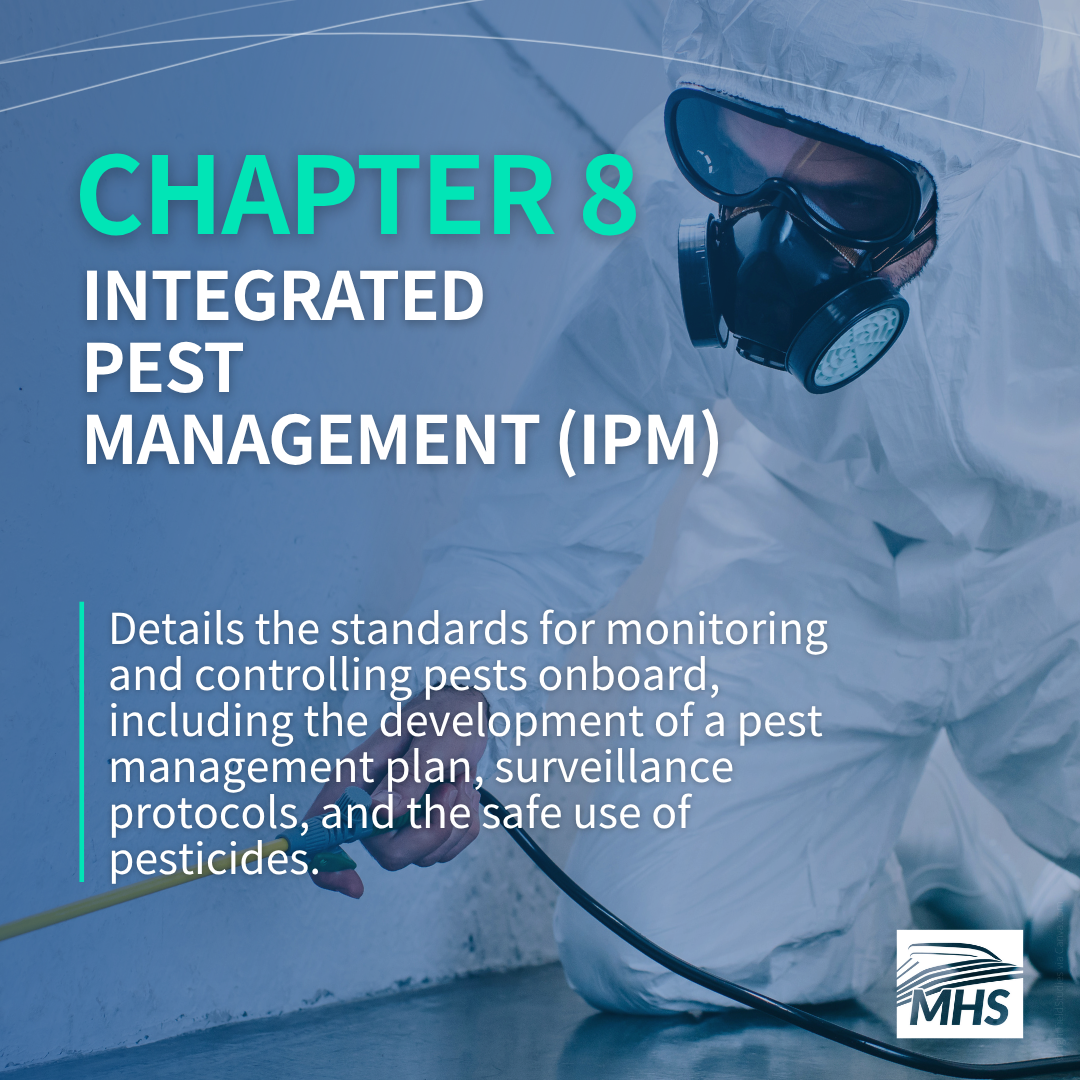
Section 8.2.1.2 – Exclusion
What’s new:
The only revision in the IPM section is a clarification that rat guards must be “used according to the manufacturer’s specifications.”
What it means:
Ships must ensure that:
- A copy of the manufacturer’s specifications is available onboard
- Rat guards are installed according to both the manufacturer’s instructions and VSP requirements
This change adds a new layer of documentation and compliance that may be reviewed during inspection.
Chapter 9: Housekeeping
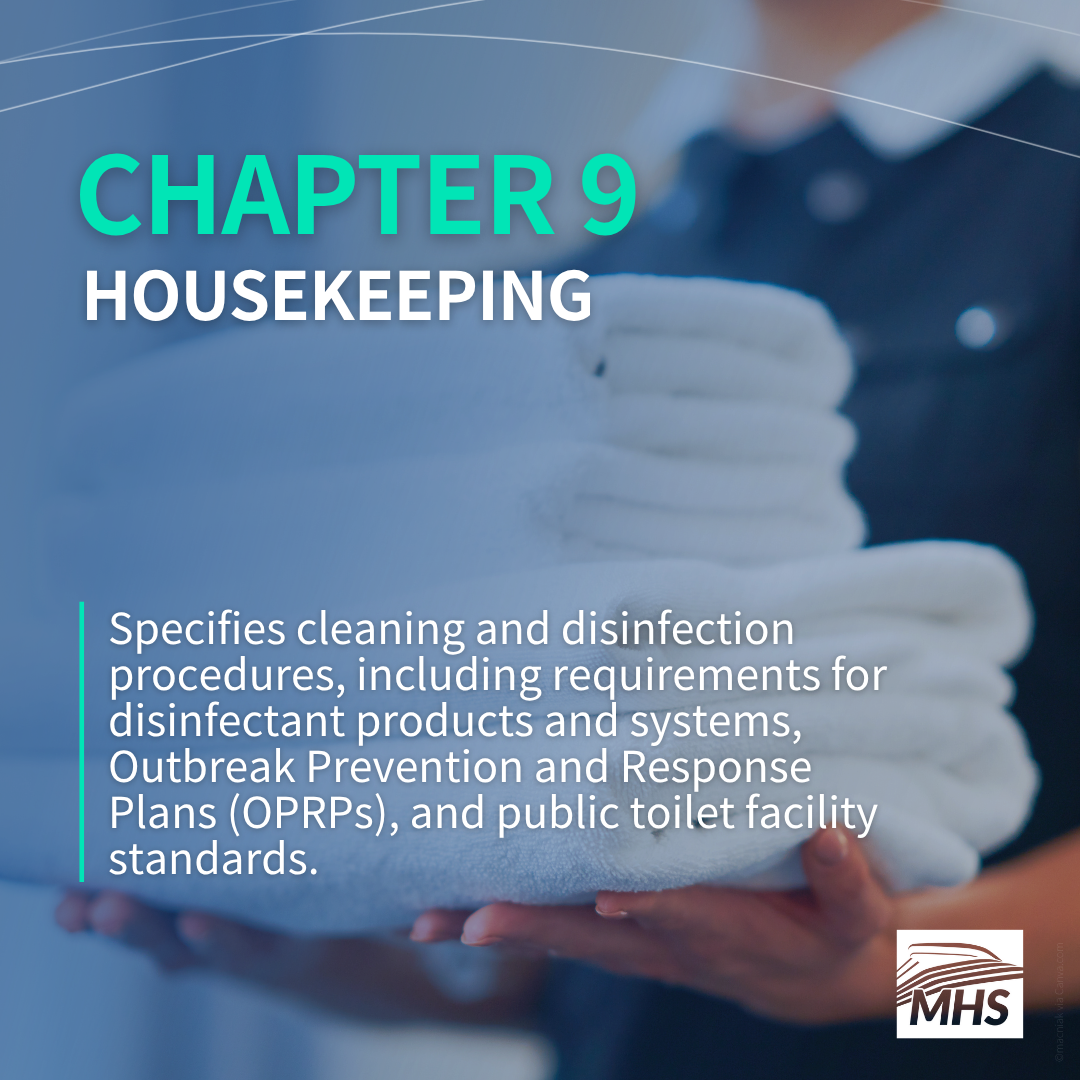
Section 9.1.1.1 – Disinfectant
What’s new:
This new section outlines requirements for disinfectant products and systems, including on-site disinfectant generators such as those producing hypochlorous acid (HOCl). These systems must:
- Be proven effective against human norovirus (or an acceptable surrogate)
- Be used according to the manufacturer’s instructions (e.g., concentration, contact time, approved surfaces)
The update also introduces a clear requirement that surfaces must be thoroughly cleaned before disinfection.
What it means:
The emphasis on cleaning before disinfection addresses a common gap in practice—spraying disinfectant directly onto surfaces without cleaning them first. Studies consistently show that disinfectants are significantly less effective on soiled surfaces.
Cruise lines should review current procedures, confirm that required system documentation is available onboard, and update Outbreak Prevention and Response Plans (OPRPs) to reflect the new standards.
Section 9.1.2 – Written OPRP
What’s new:
The list of required elements for OPRPs has been expanded to include on-site disinfectant generators. Where these systems are used, OPRPs must specify:
- A list of surfaces/items the product will be applied to
- Key parameters such as concentration, contact time, pH, approved surfaces, and any other relevant factors
What it means:
To comply with the updated standards, cruise lines using on-site disinfectant generators must revise their OPRPs AND ensure the following documentation is available onboard for inspection:
- Studies demonstrating the product’s efficacy against human norovirus (or an accepted surrogate)
- Manufacturer guidance including full operating and maintenance instructions for the system
Chapter 10: Child Activity Centers
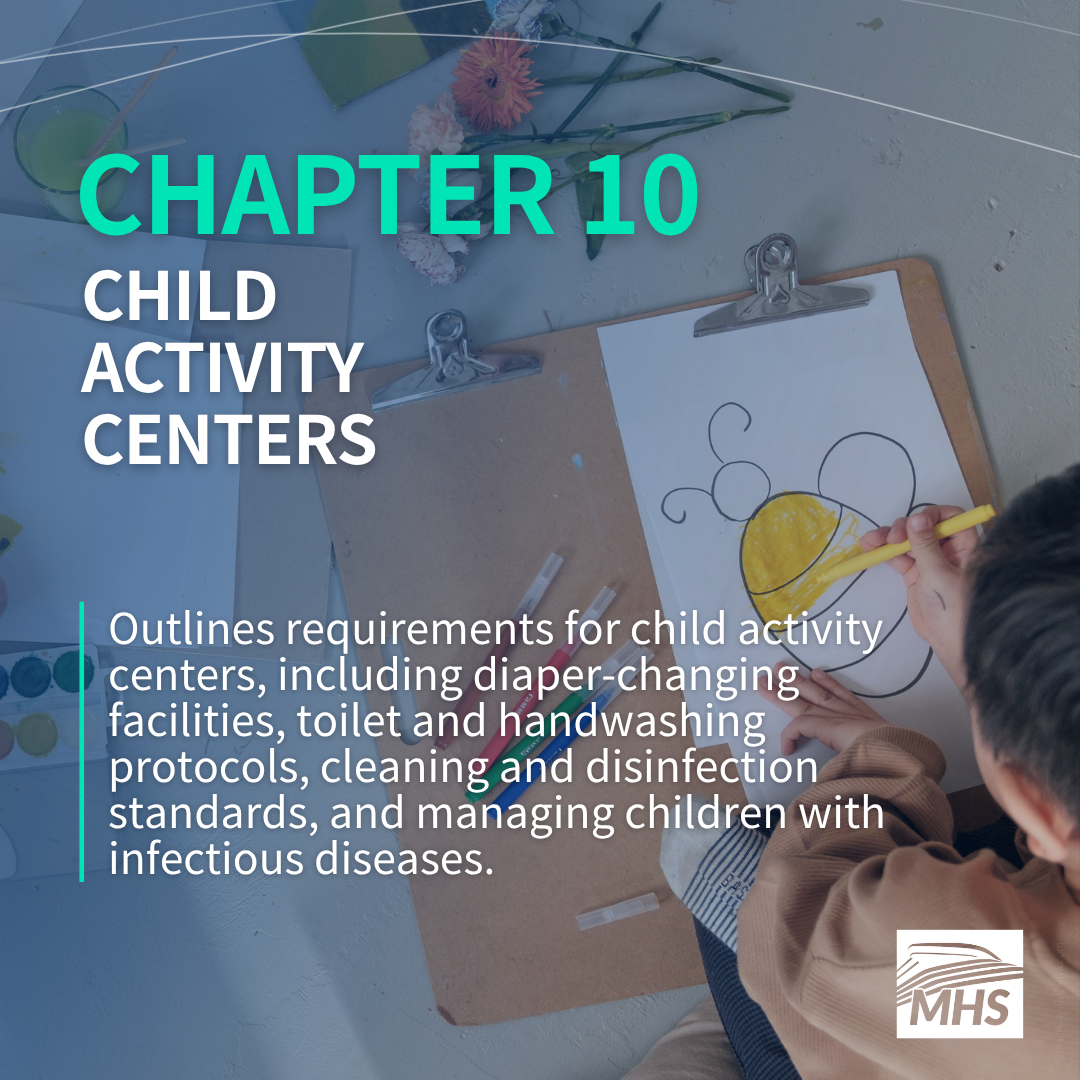
Section 10.2.2.1 – Child-Sized Toilet
What’s new:
The maximum allowable height for child-sized toilets (including the seat) has been increased from 280 millimeters (11 inches) to 305 millimeters (12 inches) above the deck.
What it means:
This small but practical adjustment gives cruise lines added flexibility when selecting or installing child-sized toilets in child activity centers. The increased height allows for better accommodation of a wider age range while maintaining compliance with VSP standards.
Section 10.2.2.5 – Signs
What’s new:
Handwashing reminder signs posted in children’s toilet rooms must now display the following wording:
“Wash your hands and assist the children with handwashing after helping them use the toilet.”
What it means:
Unlike the 2018 manual, the 2025 standards require this wording to appear verbatim. Teams should review signage in all children’s toilet rooms within child activity centers and update as needed to ensure full compliance and avoid inspection violations.
Staying Ahead of the Curve
While the 2025 VSP Environmental Public Health Standards are designed to elevate disease prevention on cruise ships, they also introduce significant operational demands.
Compliance will require targeted investment, particularly for older vessels and larger ships with a plethora of recreational water facilities. The expanded requirements will also increase the workload for crew: a reality cruise line leadership cannot afford to overlook.
Yet adapting to these changes isn’t just about passing inspections. It’s about building systems that genuinely safeguard health at sea. That means reassessing procedures, retraining staff, reevaluating crew complements, and updating documentation to ensure full alignment with the new manual.
In a year already shaped by repeated outbreaks, meeting this moment isn’t just a responsibility—it’s an opportunity to set a stronger course for the future of cruising.

